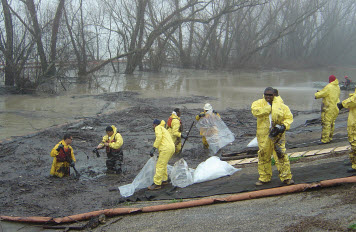Oil Spills in Rivers

- Some oils are denser than river water.
Oil usually floats because it is less dense than the water it is floating on. (Density is the mass, or weight, of a substance divided by its volume.) The density of river water is usually about 1 gram per cubic centimeter (g/cc).
Water in the open ocean is more dense (usually around 1.02 to 1.03 g/cc) because it contains more salt (the higher the salinity of water, the more dense it is). Densities of oils range from 0.85 g/cc for a very light oil (like gasoline) to 1.04 g/cc (for a very, very heavy oil). Most types of oils have densities between about 0.90 and 0.98 g/cc. These oils will float in either a river or the ocean. But very heavy oils, which have a density of 1.01 g/cc, would float in the ocean, but sink in a river.
Sometimes the density of an oil is so close to that of river water that the oil moves along the river partly underwater. When such oil finally moves into the ocean at the river mouth, it can refloat! This doesn't happen very often, but it's something we have to think about whenever oil is spilled in a river.
If spilled oil sinks, it can be very difficult to clean up. If something causes it to pool on the bottom (for example, it may get trapped behind a sunken vessel), then vacuum devices can be used to try and get the oil off the bottom. As you might guess, this method may not be very effective because vacuums may capture a lot of water and sand along with the oil.
- Movement is usually downstream. Unlike in a bay or the open ocean, currents in a river are generally directed downstream (except very close to the mouth of the river, where it enters the ocean; here, a flood tide might actually reverse the flow of the surface water). The greater predictability of river currents makes it easier to forecast which way the oil will move. Wind blowing across the river also affects where the oil will come ashore. If the wind is blowing straight down the river (as might happen on a river with high banks), it often will travel quite far down the river before it comes in contact with a beach. In order for the oil to beach, the wind must blow the oil to one side of the river or the other. You can see how the wind affects movement of an oil slick by looking at some predictions from GNOME, our oil spill trajectory model.
- Dams and locks influence oil movement. Rivers sometimes contain dams or locks that slow or divert water flow. Dams and locks also slow down the movement of spilled oil. In fact, oil tends to collect in areas next to dams or locks, where it can be picked up from the surface of the water by skimmers (devices that "skim" the oil off the water surface), sorbent pads (big square pads of an absorbing material that the oil will stick to), or sorbent booms (which work like sorbent pads, but look more like a string of sausages made out of the inside of disposable diapers!).
- Vegetation may grow right at the water's edge. Along many rivers, plants and trees grow right up to the river's edge. Those rivers don't have the open, sandy shores that you find along many parts of the open coast. It's much harder to remove oil from vegetation than from a hard-packed sand beach. Spill responders try to protect the plants by using booms, but if the vegetation gets oiled, responders often either cut, burn, or flush it with water to try to get the oil out.
- Oil can interact with sediment carried by rivers. Rivers often carry a lot of sediment in their currents. That means when oil droplets drift into the water column of a river, the sediment has the potential to stick to the oil droplets. Eventually (depending on how strong-flowing and full of sediment a river is) some of the oil-sediment combination may settle out to the bottom of the river, usually near the river mouth as the water slows down and reaches the ocean.
 An official website of the United States government.
An official website of the United States government. 